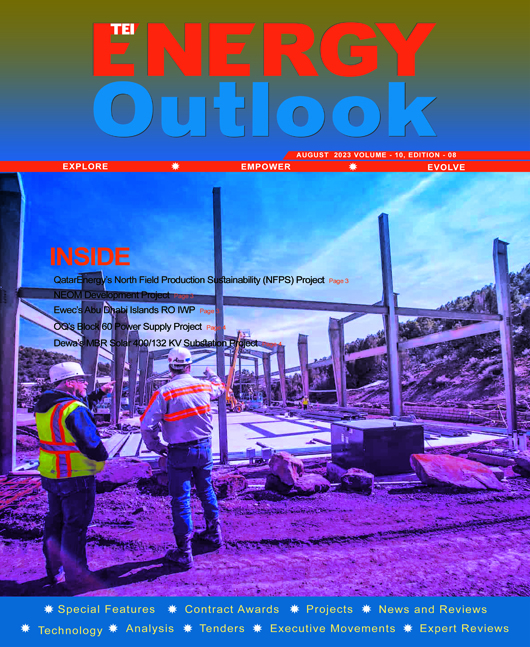
Top Projects in Gulf
The GCC region has been more upbeat in comparison to the rest of the world, supported by relatively high oil prices and growth in the non-oil economy, as well as moderating inflation.
GCC project awards surged 86% during Q2-2023 to reach $49.7 billion as compared to $26.7bn in awards during Q2-2022. This was the highest quarterly project awards value for over five years.
The economies of the GCC are projected to grow at a slower pace in 2023 compared to the previous year, according to the new World Bank Gulf Economic Update (GEU). However, the decline of economic forecast and the oil production cut is expected to have minimal impact on the region’s project market and capital spending.
Currently, several landmark energy projects are being executed in the Middle East region to embrace changing trends in the energy industry.
Saudi Arabia remains the largest projects market in the GCC as well as the Mena region. It has the largest pipeline of projects worth around $1.18 trillion in the ‘to be awarded’ stage. Total GCC contracts that are in tender or most likely to be awarded this year are expected to surpass $110bn in 2023.
The Saudi giga-projects market has more than $750bn worth of contracts in the pipeline. NEOM, the $500bn project by Saudi Arabia’s PIF, is the flagship project of the Saudi Arabia 2030 Vision aimed at diversifying the economy and thus paving the way to more stable growth.
Saudi Arabia plans to tender the world’s largest oil-to-chemicals complex, with a capacity of 400,000 barrels a day, in late 2017. The complex will be developed by a joint venture of Saudi Basic Industries Corporation (Sabic) and Saudi Aramco. The project scope involves producing more complex plastics products that can be sold in international markets. This would help in diversifying Saudi’s economy away from a reliance on crude sales.
Aramco and TotalEnergies are building a world scale petrochemical facility at Jubail in Saudi Arabia. The $11bn "Amiral" complex will house the largest mixed-load steam cracker in the Gulf, with a capacity to produce 1.65 million tons (mt) of ethylene and other industrial gases per year.
Some of the major oil & gas schemes ongoing in the region are in the UAE. The ADNOC’s $20bn Hail and Ghasha Sour Gas Field Development Project aims at producing up to 1.5 bscfd of sour gas plus additional condensate. The project is intended to increase the UAE’s domestic gas production by 18%. The client is also developing the megaproject to increase the premier offshore field’s oil production potential to 1 million barrels a day by 2024. It is called Upper Zakum offshore field expansion megaproject (UZ1000).
The biggest transformation is the drive to diversify the region’s energy mix. Alongwith, solar and wind projects, the region is now procuring waste-to-energy and nuclear power projects.
Saudi Arabia has signed multiple agreements in various nuclear-technology sectors through the King Abdullah City for Atomic and Renewable Energy. The client is building 17.6 gigawatts of nuclear capacity with a total value of $40bn, requiring about 16 reactors.
Apicorp’s analysis shows that blue and green hydrogen will dominate the emerging hydrogen markets in the near term across the region. Mena is well positioned to supply around 10 to 20% of the global hydrogen market by 2050. The UAE, Saudi Arabia and Oman have so far been the most aggressive in advancing hydrogen.
Oman aims to produce at least 1 million tons of renewable hydrogen a year by 2030, up to 3.75 mt by 2040 – and up to 8.5 mt by 2050. In total it will need around $140bn in investment. Hydrogen Oman has signed the official contracts worth $20bn-plus with the developers of the proposed green hydrogen projects in the sultanate.
The world’s biggest gas exporter market, Qatar, is building massive LNG project worth $38bn. 6 new LNG trains are being installed at Ras Laffan with the intent to produce an additional 37.2 mtpa of LNG from the site. This will increase Qatar’s total production capacity from 77 mtpa to 126 mtpa.
Outside of the GCC, Iraq has a growing projects market. Its National Investment Commission (NIC) has announced three investment opportunities in the oil refining sector worth nearly $25bn. Recently, Iraq and French oil major TotalEnergies have signed a $27bn deal to increase oil production and boost the country's capacity to produce energy with four oil, gas and renewables projects.
The GCC’s economic outlook is strong. The region is taking impressive steps to improve the business environment and attract foreign investment.
Editor